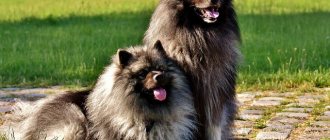How long Spitz live on average is indicated in the literature on the breed. This figure ranges from 12 to 15 years. Under ideal conditions, when the pet’s health is carefully maintained, it can live up to 20 years. For the proper functioning of a small dog’s body, the factors on which the pet’s life expectancy depends are taken into account. Without this, you cannot count on the animal being around for a long time.
Mating of German Spitz
When can you breed a Pomeranian?
The question is not at all idle. Yes, there is a breeding regulation that states that dogs of small breeds, and therefore small and dwarf Spitz dogs, can be bred at 15 months for females and at 12 for males.
Just don’t confuse physiological maturity with sexual maturity. A bitch can have her first heat at 9 months, but a male dog begins to be interested in ladies even earlier. But this does not mean that dogs can be bred at such a young age.
Read also: Manicure with faces on nails 2021-2022
How can you tell if your dog is ripe?
- Firstly, by his appearance. Your Pomeranian should look like adult dogs. Be of standard height and weight. In females, an indicator of maturity is also the establishment of a regular sexual cycle, i.e. Before the first mating, the pet must go through at least two heats.
- The health of the dog at the time of mating is no less important. Under no circumstances should you breed a bitch after an illness who suffers from a lack of vitamins or is too thin or fat. Ideally, before any mating, the dog needs to be examined by a veterinarian and undergo tests. Well, the owner of a male dog must be prepared to present a certificate confirming that the pet is free of infections.
Choosing a partner. Pay attention to color and size
In addition to the usual requirements for the prospective groom (bride), namely compliance with the standard, absence of serious flaws and vices, impeccable health, when selecting a partner for mating a Spitz, it is important to take into account its size and color.
When breeding German Spitz, the male may well be the same size as the female, or slightly larger. Although, breeders tend to give preference to smaller individuals.
Spitz colors are a little more complicated.
To at least somehow understand what to expect from the mating of a particular breeding pair, be sure to study the pedigrees of the dogs. See what color the ancestors of your pet and his future partner were. And even if you breed two dogs of the same color, there may be puppies in the litter that resemble their grandparents. This is where the genes come into play.
- For example, a pair of black Spitz dogs can be expected to produce offspring of any color.
- A litter from two brown dogs is more stable, but there may be puppies with very light brown, which means a color defect. You can also get tan or sable babies from a brown pair.
- By the way, to obtain Spitz dogs of a brighter brown color, brown dogs are often bred with black dogs.
- As for red pets, puppies most often turn out to be of various shades of red and beige. But again a lot depends on the ancestors.
- If red Spitz dogs predominate in the pedigree of the dogs, then there is no need to expect surprises in color. Otherwise, do not be surprised by the appearance of a sable or even white puppy.
- Mating white Spitz dogs usually results in the birth of white babies. Grays can also give birth to red and tan puppies.
- And a pair of red + sable can produce children of a variety of colors.
- But it is better to breed color party Spitz dogs (black and red heels on white) only with each other. Any single-colored partner, in this case, can cause the puppies to have spots that are too large and do not meet the standard. The same result can be achieved by mating white Spitz dogs with colored ones.
Small German Spitz
This variety is already much closer to decorative breeds than the previous ones, but is not yet such a button as the orange. It is a little larger in size, so if very tiny dogs cause you confusion (or you are afraid to step on them... jokes aside, but this really happens sometimes) - the small German Spitz is suitable for you.
Tags
German Spitz German Spitz.adult Spitz ToyGerman Spitz German Spitz German Spitz German Spitz German Spitz German Spitz and German Spitz are noisy of this breed so the standard of the breed of each Diseases of the breed cons of the breed History of the breed German Similar breeds are decorative breeds. This breed has many varieties of the breed according to the variety of the breed. German Spitz German Spitz.like a German Spitztemperament of German SpitzLarge German SpitzMedium German SpitzSmall German SpitzMiniature German Spitz
rodents standard is cats answer
Origin story
Officially, the breed is called the Dwarf Pomeranian. The Pomeranian Spitz is a representative of the Spitz group, which includes the Pomeranian, medium, Keeshond, etc. The birthplace of this breed is considered to be Germany, namely Pomerania, the historical region from which the name Pomeranian Spitz originated. The Spitz family has a longer history: their ancestor is considered to be a turf dog that lived several thousand years before the advent of the new era.
For a time, Spitz dogs were considered the poor man's pet. But in the 18th century, wealthy nobles paid attention to this breed. Later, the Pomeranians came from their homeland to England, where they were appreciated by Queen Victoria. It is not surprising that her pet, the Pomeranian Marco, soon charmed her subjects, and there was a real boom in this breed in the country.
Queen Victoria's pet - Spitz Marco
Similar breeds
They look like big Spitz dogs:
- Samoyed husky;
- Akita Inu, Shiba Inu;
- Chow-chow;
- Unexpectedly, but malamute and husky;
- Swedish, Finnish laphund;
Similar to medium-sized Spitz:
- Japanese Spitz;
- Valpino Italiano;
- Small Poodle (similar in size, temperament, versatility).
- In terms of cuteness and luxurious coat, Welsh Corgis are similar to large Spitz dogs.
Similar to the Small Spitz and Pomeranian:
- Miniature, toy poodle;
- Shih Tzu;
- Papillon;
- Bichon Frize or Maltese;
- Pekingese.
How to find out the age of a pet
There are a number of signs that will help you easily determine the age of a dog of any breed, including the Pomeranian. This can be done by assessing the condition of the dog's teeth, fur and eyes.
The most detailed information about how many years a Pomeranian has lived can be found in its teeth:
- Newborn puppies have no teeth.
- At 3 weeks, the Pomeranian has only fangs.
- At 2 months the dog already has all his baby teeth.
- At 6 months, the replacement of primary canines with permanent ones begins.
- By 8 months, the process of changing teeth in Pomeranians is completely completed.
- One-year-old Pomeranians have a full row of white permanent teeth.
- At the age of 5, the tubercles on all incisors usually wear out, and the teeth begin to turn yellow.
- By the age of 6, the canines become dull and the incisors become concave.
- From the age of 10, the dog’s number of teeth gradually decreases – they begin to loosen and fall out.
The approximate age of an orange can be determined by the condition of its coat:
- in young dogs it is shiny and silky, of uniform color;
- in older dogs - dull, and sometimes with bald spots.
The same can be said about a dog's eyes. Typically, older Pomeranians, like representatives of any other breed, have dull and deep-set eyes and a dull look.
Characteristics: size, description, types
- height at withers 18-22 cm;
- weight – up to 3.5 kg (some individuals weigh more and are classified in a separate category).
These are the sizes of the Pomeranian Spitz today. The dog looks like a light fluffy ball. Due to the very dense thick undercoat, the dog’s outer coat stands on end, not adjacent to the body - it seems like a weightless cloud. Due to its short, strong body and hair sticking out in all directions, the Spitz looks round. And only a special haircut allows you to see that he has a slender and well-proportioned body. The photos of these dogs with bear haircuts are very touching. Everything about this dog, and not only because of the fur, is somehow rounded: the dog’s skull, its intelligent eyes, its curling tail, and its voluminous collar. Only the ears are small and pointed. The distance between them is small.
The dog's face deserves a separate description, because this miracle can have a face like a bear cub, like a fox, or like a funny toy. Based on the appearance of their muzzle, the following types of Pomeranian Spitz are distinguished:
- bearish type;
- fox type;
- toy type.
The Pomeranian is a real beauty. Regardless of which of the three types of breed is chosen, the dog will have a charming face and its own distinctive features
The most popular dog today is the “bear cub”. His chubby cheeks, like those of a bear, and his black round button eyes on his flattened face, which are located closer to his nose than those of dogs of this breed, but of a different type, look very touching. The unusual “bearness” effect was achieved by breeders mainly with the help of thick hair in the cheekbone area.
But unfortunately, at the age of 1-2 months, when it’s time to pick up the puppy, it is impossible to determine what kind of face it will have in adulthood. Only by the age of one year do Pomeranian Spitz puppies develop into adults according to their physical characteristics. Then you will find out who you bought: the “bear cub”, the “little fox” (with its sharper and elongated muzzle). Or maybe you got a toy type, which has a less flattened face than its bear-type relatives and wide-set eyes.
Average life expectancy of a Pomeranian
So, Pomeranians are considered long-lived among dogs. Some of them even live up to 15 years. Their minimum lifespan is 12 years. If the pet has received high-quality and proper care, then it will be able to delight its owners with its presence even longer and live up to 20 years. But care is not the only criterion; the size of the dog also affects its lifespan. Dwarfs live the shortest. No longer than 7 years.
Diseases of the Pomeranian Spitz
Pomeranians are predisposed to a number of diseases:
- Metabolic disease. One of the deviations is hypoglycemia. To eliminate it, you need to feed your pet often and in small portions.
- Eye diseases. Anatomical predisposition to tearfulness, lens opacities, eyelid pathologies, risk of eye injuries, pathology associated with retinal dystrophy.
- Congenital displacement of the kneecap. This pathology is genetic. Trauma can trigger the progression of the disease.
- Black skin. Baldness or partial hair loss often develops.
Genetic disorders
Spitz breeding has been going on for over 100 years. In this case, serious mistakes are often made. Such errors lead to the appearance of various genetic errors that affect the pet’s lifespan.
Among the hereditary pathologies in dwarf Spitz dogs, cryptorchidism is often found, and there is also a risk of developing diabetes. Pigmentation disorders in representatives of the breed also have a hereditary nature.
Dogs often have dental problems, such as tartar. Another serious disease is epilepsy, which is transmitted genetically.
Caring for Pomeranians
The rules for caring for almost any dog are the same. This includes a proper diet, regular walking, and maintaining the Spitz’s coat in perfect condition. The Spitz's coat is thick and requires careful and thorough grooming. The dog needs to be brushed regularly. To maintain the beauty of the coat, you need to purchase several special combs. You will need a slicker brush, a brush with bristle teeth, and a massage comb.
Causes of premature death
A toy, not a dog
In order for a pet to live as long as possible, it is necessary to provide it with appropriate care.
First of all, it should be a complete absence of stress. The tiny dog generally reacts very sensitively to swearing and any conflicts in the family. As a result, he begins to tremble, tries to climb into his owner’s arms, hide, or runs and barks furiously. Any of these reactions negatively affects his well-being and causes serious damage to the entire nervous system.
An additional risk comes from various injuries.
Spitz dogs are generally quite susceptible to them - the reason for this is their small body with thin bones and a very active lifestyle. The dog may well jump from the high sofa onto the floor and break his paw in the process. Attention! It is advisable to groom Spitz dogs in the warm season, otherwise there is a high risk of rapid hypothermia and colds.
Like many decorative dogs, Spitz dogs suffer from a fairly wide range of common diseases. Experts usually include in this list:
- neoplasms affecting external and internal organs;
- inflammation of the pancreas and intestines;
- joint diseases;
- disruptions in the functioning of the heart and liver.
Finally, poor diet can also have a serious impact on life expectancy. If the dog does not receive enough microelements, this may well lead to a variety of diseases. And an excess of calories with an insufficiently active lifestyle will definitely cause obesity, in which the animal will live 2-4 years less than it could.
Therefore, there are simply no trifles in caring for a Spitz - it is necessary to provide him with truly ideal conditions so that he can live as long as possible.
Why do dwarfs die early?
Super-mini breed is one of the most popular today. They have no dog smell at all, and their miniature size allows you not to part with your pet and take it with you anywhere. At the same time, the life of babies is very short.
It is not for nothing that the standard stipulated a height of at least 20 cm; this allows the pet to maintain normal health and ensure its survival until old age.
Dwarfs have very brittle bones and a very sensitive pancreas. Even in ideal conditions they will not be able to live more than 10 years. This is a record figure for minis.
Minik
Caring for German Spitz
Even though the German Spitz will feel happier living in the countryside, he adapts very well to city life, especially to living in apartments. In any case, this is a dog that needs to spend time on long daily trips, during which he can exercise and especially spend time with his teachers.
Important fact: The beautiful fur of the German Spitz requires careful care. You need to brush him several times a week or even every day to maintain the beauty of his coat. The German Spitz sheds twice a year, during which time it loses a lot of hair.
German Spitz are very smart dogs that quickly and easily learn new things. Unfortunately, they are not easy to train. They often require a lot of love and attention from their families. When this attention is absent or insufficient, they become stubborn and very difficult to train. However, when you show them the love and attention they crave, they will do anything to please their owner. This must be done with caution because when they realize that you are meek and always submit to their demands, they also become stubborn.
Therefore, the first step in training them is to gain their loyalty and confidence. They often react very poorly when they are forced to do something. This is why positive reinforcement is the best training method for them. Once they are motivated to do what their owners want, there is no limit to what they can be taught.
Although they have been used as herding and guard dogs for most of their history, the German Spitz is best suited as a guard dog. Whenever a stranger appears, they bark excessively until their owner tells them to stop. Their sense of loyalty, humor and playfulness also make them excellent companion dogs.
Upbringing
The pets are well trained. Their distinctive features are a sharp mind and unquestioning obedience. Therefore, there will be no problems with education.
The German Spitz dog breed requires a gentle approach. The pets really try to please the owner and do not try to challenge orders or cheat. Therefore, if the dogs do not understand something, it is the trainer’s fault. You cannot be angry with your pets - screams and discontent will frighten them and make them withdrawn.
The general course of Pomeranian training is mastered by six months. Afterwards, they can be taught circus tricks - they dance with pleasure, stand on their hind legs, jump on the owner’s back, and “die.”
No matter how quickly the German Spitz learns the rules of behavior, education cannot be left to chance. No dog is born obedient - it needs to be trained.
How to extend the life of a dog
The owner of a Pomeranian Spitz can extend the life of his pet by providing him with competent care, timely treatment and surrounding him with attention and care.
The right diet
It is better to choose premium ready-made food for ornamental breeds, paying attention not only to its manufacturer, but also to the seller. If your dog eats natural food, you need to carefully monitor the quality of the food.
You should also not feed your pet:
- smoked meats;
- sweets;
- sausages;
- pickles.
The dog's diet must be balanced so that the Pomeranian receives all the vitamins and microelements it needs.
Upon reaching 4 years of age, it would be advisable to introduce special supplements to the menu of a pet who prefers natural food to strengthen joints and bones. In addition, it is recommended to partially replace fattier meat with fish.
If your Pomeranian eats ready-made food, it is advisable to purchase food designed specifically for adult German Spitz dogs.
It is important to carefully monitor your dog's weight and not overfeed him. After all, regular overeating contributes to the development of obesity and cardiovascular diseases.
Walks and games
Long regular walks and active games also affect the life expectancy of the orange. You need to walk with representatives of the breed for at least 1 hour 2-3 times a day.
Dogs that don't get the exercise they need and spend little time outdoors tend to live shorter lives. After all, they often suffer from excess weight and muscle tissue atrophy.
True, you shouldn’t overdo it with physical exercises for your little pet either. Exercising too intensely can lead to joint injuries and stress.
It is important! You should not shorten your walk time or avoid games and activities with a pet that has reached old age. Veterinarians recommend continuing your normal lifestyle without making any concessions to the dog’s age.
Timely treatment and deworming
Timely treatment and vaccination is the key to a long and happy life for the Pomeranian.
Representatives of the breed under 7 years of age must visit a veterinarian once a year for a routine examination. Dogs over 7 years old are recommended to be seen by a doctor every six months.
If there is the slightest change in your pet’s behavior or signs of poor health, you should immediately go to the nearest hospital. Also, we must not forget about the annual vaccination of the dog.
An important condition for good care, which affects life expectancy, is regular deworming and getting rid of external parasites. Antihelminthic medications should be given to your Pomeranian every 3 months.
In addition, in the warm season, it is necessary to treat the dog for fleas, and after each walk outside the city, check for ticks.
Care and hygiene
Representatives of the breed need regular coat and eye care, nail trimming, teeth and ear cleaning:
- During the hot season, Pomeranians must be trimmed to avoid overheating. In addition, dogs of this breed need to be thoroughly brushed every week, and daily during periods of shedding. Spitz dogs also need to be bathed monthly and given a hygienic haircut as necessary.
- The eyes of representatives of the breed are cleaned of dirt once a week with a cotton pad soaked in a special lotion or chamomile decoction.
- Dogs' nails usually wear down on their own during walks. If this does not happen, they need to be trimmed carefully.
- To avoid the formation of tartar, Spitz teeth should also be periodically brushed using special brushes. You can also offer your pet to chew on a special chewing bone.
- Your pet's ears should be checked weekly for dirt and cleaned as needed.
Character and behavior of dogs
Spitz dogs were obtained from northern sled dogs, so their smaller versions retained the character of a large and confident dog. Owners have noticed more than once how a small pet fearlessly and courageously rushes to attack larger “opponents”. They are always and everywhere ready to defend their owner and their territory.
On the one hand, this is a sincere companion dog, on the other, a self-sufficient and determined dog. By nature, Pomeranians are always cheerful, cheerful and easy-going. Wherever the owner goes, they are ready to keep company.
Interesting Facts
- Thanks to his high mental abilities, the Spitz makes an excellent service dog. There are examples of dogs being involved in rescue work.
- The dog does not lose its activity even with the onset of old age. The Spitz always prefers active movement and persistently encourages the owner to go for a walk. Once you get a dog, you will have to forget about relaxing on the couch for a long time.
- Brown Spitz dogs are often confused with small bear cubs.
- The Russian chestnut is a young breed, the fruit of the work of a dog handler from Vladivostok, Svetlana Belogurova. For 8 years, she crossed Dachshunds and Pomeranians, mixing in the genes of outbred dogs whose appearance resembled Chekhov's Kashtanka. Today more than 150 Russian chestnuts are known. Dogs have excellent qualities as a companion, a loyal friend. They are smart, easy to train, and can do any dog sport.
Prepared for the exhibition
What factors influence life expectancy
There are many circumstances that can negatively affect the life expectancy of a Pomeranian. A significant part of them are multiple diseases to which the dog becomes prone after 4 years of age.
There is no point in considering hereditary diseases, since it is impossible to prevent their occurrence. Another issue is acquired diseases, which, depending on their severity, shorten the life of a Pomeranian by four to six years. The most common of them caused by improper care are:
- Liver dysfunction.
- Inflammation of the pancreas and intestines.
- Neoplasms in the intestines.
- Malignant neoplasms in various parts of the body.
- Joint diseases.
- Circulatory disorders, particularly in the brain.
- Heart dysfunction.
But the most common and dangerous problem is bone fractures. The Pomeranian Spitz has a very fragile structure, so any force on the skeleton can result in serious injury. Even if it is received at an early age, in old age pain in this place will have a detrimental effect on the heart.
The problems listed above are caused by improper care of your pet. Common mistakes when keeping a Pomeranian include:
- Incorrect or poor quality nutrition. If the diet prescribed for this breed is violated, for example, feeding from the table, the likelihood of diseases of the pancreas and digestive system increases significantly.
- Decreased physical activity. The Pomeranian requires daily walks, in the absence of which problems with the joints begin. Despite its small size, moving around the apartment is not enough for this breed. But with sufficient walking, a city apartment will not become a negative factor that shortens the dog’s lifespan.
- Lack of vaccinations. Without vaccination, the puppy's chances of contracting enteritis or distemper are very high. Severe viral diseases significantly shorten the overall lifespan of a pet.
- Lack of antiparasitic protection. Without a special collar that protects the Pomeranian from ticks and fleas, the pet's health will be undermined. In addition to the fact that ticks weaken the host’s body by sucking blood, they also carry very serious diseases.
- Frequent stress. The Pomeranian has a very weak psyche; difficult experiences have a strong impact on the heart and can lead to a heart attack. This breed should not be severely punished or frightened.
- Dog overheating. The breed does not tolerate heat and direct summer sun. Overheating leads to an increase in heart rate - the load on the heart, which has negative consequences.
- Lack of treatment for breed diseases. Bitter orange is characterized by inflammation of the paranal glands, which must be treated at an early stage.
Who to choose - a boy or a girl?
You should decide on the gender of your future pet before purchasing it - males and females have some differences in character and content that need to be taken into account.
Boys are less emotional, but at the same time more aggressively guard their territory and are often prone to fights with other dogs, even if they are much larger.
They are stubborn and willful, which can cause difficulties during training, so the owners of male dogs will need to show more patience and perseverance.
It is also more difficult to accustom male dogs to a litter box or diaper due to their physiological characteristics, which determine the desire to mark territory. In addition, boys react to bitches in heat throughout the year, which can lead to them running away and losing their pet.
If you have plans to breed the breed, you should purchase a female.
In addition, girls have a softer and more flexible character; they are easier to train and toilet train. At the same time, they are prone to manipulation and more males need the attention of the owner.
Also, some difficulties can be caused by estrus, during which changes in the character and behavior of the dog are possible.
How many years do they live
The average life expectancy of the Small German Spitz is 14-15 years. This breed is characterized by good health and a low likelihood of developing hereditary pathologies. The lifespan of an animal largely depends on the conditions of its detention. If an attentive and loving owner provides the pet with good care, its lifespan can last up to 20 years or even longer. Taking care of health is of great importance, which consists of constant prevention of infectious diseases, timely vaccination, and ensuring an active lifestyle.
Unwanted crossings to obtain a non-standard color can cause genetic abnormalities and, as a result, a decrease in life expectancy.
Warning! A short muzzle, indicating a hereditary disorder in the structure of the bones of the facial part of the skull, is dangerous for the development of chronic respiratory problems. This is another common reason for a dog's lifespan to decrease.
Differences with the Pomeranian
Application
Spitz dogs are mainly bred for fun. Due to their high adaptability to the lifestyle and living conditions of people, pets are suitable for families with children, the elderly and single people.
Their lively, good-natured character has made dogs good psychologists. They are used by psychotherapists in working with withdrawn children and adults with post-traumatic syndrome.
At the same time, dogs are watchmen and security guards. They are always on the alert, warning about the visit of uninvited guests and danger. And if something threatens the owner, they will defend themselves without hesitation.
The qualities of protectors are more pronounced in large varieties of the breed. So, the German Dwarf Spitz is just a toy. He doesn’t even want to go outside again. Another thing is a large German Spitz, Keeshond or Mittelspitz. They will not be afraid of the most formidable and powerful enemy.
What to name a Pomeranian
| Boy | |||
| Allen | Alain | Kandy | Candy |
| Arno | Arno | Leon | Leon |
| Blacky | Blackie | Lucky | Lucky |
| Boss | Boss | Max | Max |
| Bruno | Bruno | Michael | Michel |
| Buddy | Buddy | Pappy | Pappy |
| Casper | Casper | Rambo | Rimbaud |
| Chickie | Chicky | Rio | Rio |
| Danny | Denny | Rocky | Rocky |
| Donnie | Donny | Sam | Sam |
| George | George | Scooby | Scooby |
| Glossy | Glossy | Skye | Sky |
| Gotty | Gotti | Smiley | Smiley |
| Erich | Erich | Snowy | Again |
| Happy | Happy | Stefan | Stephen |
| Jackie | Jackie | Toffy | Toffee |
| Jerry | Jerry | Tubby | Tabby |
| Jimee | Jimmy | Tuffi | Taffy |
Pomeranian standard.
| Girl | |||
| Adele | Adele | Maggi | Maggie |
| Angel | Angel | Milky | Milky |
| Aura | Aura | Minnie | Minnie |
| Baby | Baby | Puppy | Pappy |
| Bella | Bella | Rani | Rani |
| Blacky | Blackie | Rimbo | Rimbo |
| Candy | Candy | Rose | Rose |
| Doll | Doll | Rosee | Rosie |
| Dolly | Dolly | Roxanne | Roxanne |
| Dolphy | Dolphy | Roxy | Roxy |
| Ferry | Ferri | Ruby | Ruby |
| Fluffy | Fluffy | Snoopy | Snoopy |
| Goldi | Goldie | Snow | Snow |
| Jenny | Jenny | Spinee | Back |
| Julie | Julie | Essie | Essie |
| Kiwi | Kiwi | Timmy | Timmy |
| Lado | Lado | Tuffy | Taffy |
| Lola | Lola | Vini | Vinny |
| Lucky | Lucky | Whity | White |
| Lucy | Lucy | Willy | Willie |
Tips for owners
There are a number of tips that those who consider themselves a good owner should pay attention to:
- If there are any changes in your Spitz’s mood or behavior, it is recommended to consult a veterinarian;
- in hot weather, your pet will need a haircut to alleviate its physical condition;
- Vaccinations must be carried out on time;
- Communication with relatives is beneficial for a pet, so it is recommended to spend walks with other animals;
- It is worth noting that castration in boys also prolongs life, protecting animals from the early development of diseases of the genitourinary system.
It is important to understand that you need to constantly monitor the condition of a small dog. This is not just a cute animal, it requires careful care and regular visits to the veterinarian. Compliance with all the rules will extend the life of your beloved furry.
Rules for choosing puppies
Buying a dog should be taken seriously. After all, how long she will live depends on it. It is recommended that the decision be made thoughtfully and within the family circle.
What to pay attention to before purchasing:
- Reviews about the breeder. Having chosen a breed, it is better to find out as much information as possible about the nursery. Search the Internet or interview those who have already purchased puppies there.
- Animal genetics. If the owner of the litter does not show the dogs' parents, this indicates the presence of problems with their health.
- Help from a professional. If among your circle of acquaintances there are dog handlers or those who understand this, you should invite him with you.
- Documentation. The seller is obliged to provide information about the nursery, the official business of the breeder, and vaccination of animals.











